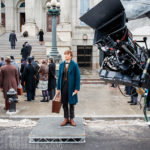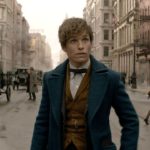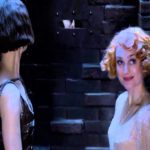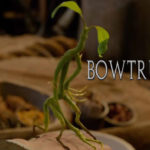Fantastic Beasts And Where To Find Them (henceforth FBAWTFT) is, of course, one of JK Rowling‘s spin-offs from the magical world created for Harry Potter in books and films, the other to date being the stage show Harry Potter and the Cursed Child (doubtless soon to be a film.) The intent is there to turn FB into a new film franchise with fruitier cast and characters – from Wikipedia:
On 14 October 2016, J.K. Rowling announced that Fantastic Beasts will be a five film series. In November 2016, it was announced that Johnny Depp would have a larger role, staring in the as-of-yet unnamed sequel to Fantastic Beasts and Where to Find Them. Yates and Rowling are contracted to return as director, and screenwriter and co-producer, respectively. Later that same month is was also announced that Albus Dumbledore would be appearing in the future instalments, albeit with a younger actor for the prequel film series. The director also expressed the intent to release an instalment every year.
I’m sure many further insights into the wizarding world will follow, but who can blame JK for exploiting her investment in time and imagination and the enchantment brought to millions through the HP series? Whether she would really want to become JK Rowling the brand, is another question. Her name is featured large as the writer and one of a bunch of Producers of this movie, though essentially this is about protecting her intellectual capital.
What we have here is an escape into the same fantasy world in another time and place, though with more than a few nods and winks to references in the books, though the biggest influence is, of course, the small but entertaining companion piece of the same name, written soon after HP7 came out. I can’t claim to have read the original Fantastic Beasts And Where To Find Them, though I’m guessing the fantastic beasts in the film probably originated in the book. At any rate, they are brought to life through the black arts of CGI one at a time, of which more in due course.
However, the really amazing achievement here is the reconstruction of 1920s New York, largely in a studio in Watford, so I hear. It is incredibly detailed, mostly dark and gothic in the fashion of Gotham, looks brilliant and is wholly convincing. The darkness is more in the lighting and direction (the esteemed David Yates, regarded in the industry as a “safe pair of hands”), of course, but I greatly like the cut of the jib – the production design is first rate.
I like the sly artfulness of Rowling’s script, notably that the lingo is different even in the wizarding world (American for “muggle” is “no-maj”), and that as the no-maj world bans alcohol, so the magic underworld has banned magical creatures. But nice to know that all the spells you knew so well from Hogwarts and British magical venues work just as well over the Atlantic.
For Potter virgins and those who were not paying attention in classes on magical history, she has written a starting point the camera poring over a host of magical newspapers, the sort where photographs and adverts move, to tell you all the background you need, notably about the evil Gellert Grindelwald, fore-runner of He Who Must Not Be Named and second on the list of “Most Dangerous Dark Wizards of All Time.”
You’d be struggling to complain about the cast too, led by likeable Oscar winner Eddie Redmayne (or RedBaby, as Mayo and Kermode now refer to him), most recently seen donning a dress in The Danish Girl. Redmayne is my daughter’s heart-throb; the camera likes him, though as Newt Scamander, a shy English wizard entering prohibition New York for the first time with a case, nay a world full of bizarre magical creatures, he becomes a rather more reticent character. That is, he barely looks any person in the eye, let alone beautiful Porpentia “Tina” Goldstein (later Mrs Scamander, as played by the beautiful Katherine Waterston), but comes to life when among his flock (or whatever collective name applies to such beasts.) Here’s a little background on Newt:
Newton Artemis Fido “Newt” Scamander is the fictional author of Fantastic Beasts and Where to Find Them, born in 1897. According to the “About the Author” section of the book, Scamander became a magizoologist because of his own interest in fabulous beasts and the encouragement of his mother, an enthusiastic Hippogriff breeder. In Hogwarts, he was sorted to Hufflepuff house. After being expelled from Hogwarts, Scamander joined the Ministry of Magic in the Department for the Regulation and Control of Magical Creatures. His career included a brief stint in the Office of House-elf Relocation, a transfer to the Beast Division, the creation of the Werewolf Register in 1947, the 1965 passage of the Ban on Experimental Breeding, and many research trips for the Dragon Research and Restraint Bureau. His contributions to Magizoology earned him an Order of Merlin, Second Class in 1979.
But back to the cast, well-furnished with established stars even if largely Depp-less on this first outing (he makes a very brief cameo right at the end – no clues!) Look, here’s a well-nourished Jon Voight as a banker and father of the NY senator; there’s Ron Perlman in a delightful cameo as a goblin gangster; what about Carmen Ejogo as President Seraphina Picquery of MACUSA, the American wizarding body and equivalent to our Minister of Magic. Oh, and mustn’t forget the delectable Alison Sudol as Tina’s sister Queenie.
Don’t you just love the always excellent Samantha Morton, who gets a look-in as the delightfully villainous Mary-Lou Barebone? Ah, and what about Ezra Miller, darker by the movie, here playing a troubled son – again (see here.) Dan Vogler plays co-lead in the form of chubby and bemused downbeat no-maj Jacob Kowalski, almost a modern day John Candy. Last but not least, though by no means the end of the splendid casting, Colin Farrell as Percival Graves, high-ranking Auror and the Director of Magical Security for MACUSA, but secretly villainous. I can’t ever recall seeing Farrell playing an evil influence before now, but maybe this is a future career direction?
Fact is, there’s not a dud note among the cast, who are certainly not outfaced by their CGI counterparts. My only real issue with them is that I struggled to hear them in several sections, in-keeping with the modern tendency for actors to mumble (to directors everywhere: can we please return to the days of clear enunciation? Thank you.) Seriously, this spoiled my ability to follow the plot, and it’s far from being the only modern example.
As for the creatures themselves, we barely see enough of most of them, certainly not enough to appreciate their mystical qualities, though I’m guessing most will come into their own in future episodes of the FBAWTFT saga. On this occasion, I’m not going to spoil the surprise for you, though you will see pictured above one or two examples – there are many more, though pictures are not widespread. However, I will say that the torment unleashed on NYC is the result of the destructive tendencies of an angry Obscurus, later necessitating the obliviating of the entire non-maj city, natch.
All well and good, then? Well, not quite. The hour or so of the movie is all about discovering the characters and creatures, but things start to go awry with the introduction of evil intent as a counterpoint to the largely well-intentioned hunt for an escaped bestiary. As my son put it, it’s as if they drifted through the first half then suddenly remembered that they needed a plot. Indeed, the film loses coherence in the middle and then re-emerges as a battle of wills for the final third, before a final ladle of schmaltz in true studio tradition. For a period, the fate of many a fantasy and superhero movie (of which this is arguably a type, akin to magical realism) occurs: CGI takes over as a substitute for intelligent discourse and narrative.
It’s certainly not that JKR is incapable of judging a plot, since she achieved this with great aplomb in the HP books, but timing a film script and weaving in the conflicting elements needs to start much earlier and to be woven in the form of complex characterisation, such that we can see the good and the bad within the narrative stream. The issue with FBAWTFT is that this process occurs rather too suddenly, as if an afterthought.
This slight flaw should not put you off seeing the film, though I’d certainly advise you to keep your hearing aids turned up and keep track of the slightly fringe characters and their relevance to proceedings.
But then, JKR is good at sagas, so this instalment is basically the springboard for a much greater battle of good versus evil – culminating, quite possibly, in Dumbledore vanquishing Grindelwald in, so we are told, 1945. The ensuing 19 years up to that point should keep writer, cast and crew busy for a good number of years yet, and a young audience hooked to the spin-offs and merchandise too. It’s a good life when people want what you’re selling!

















